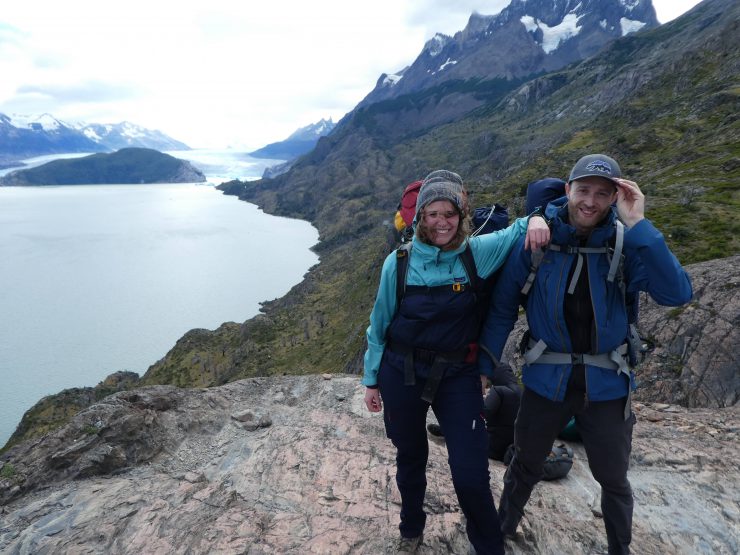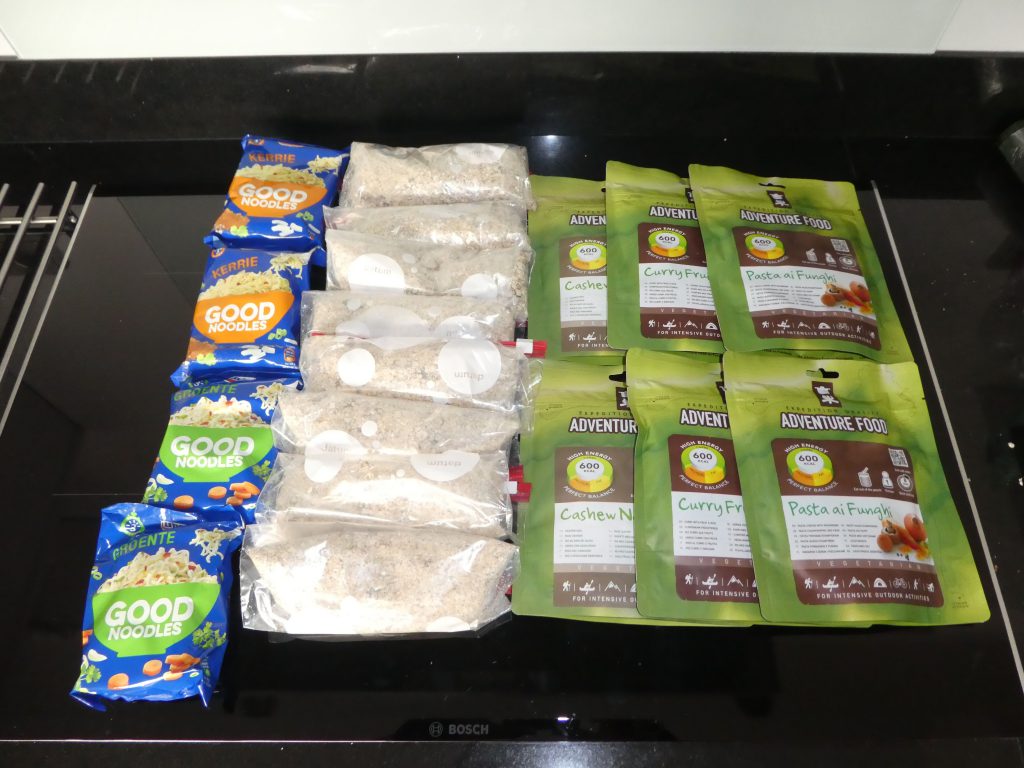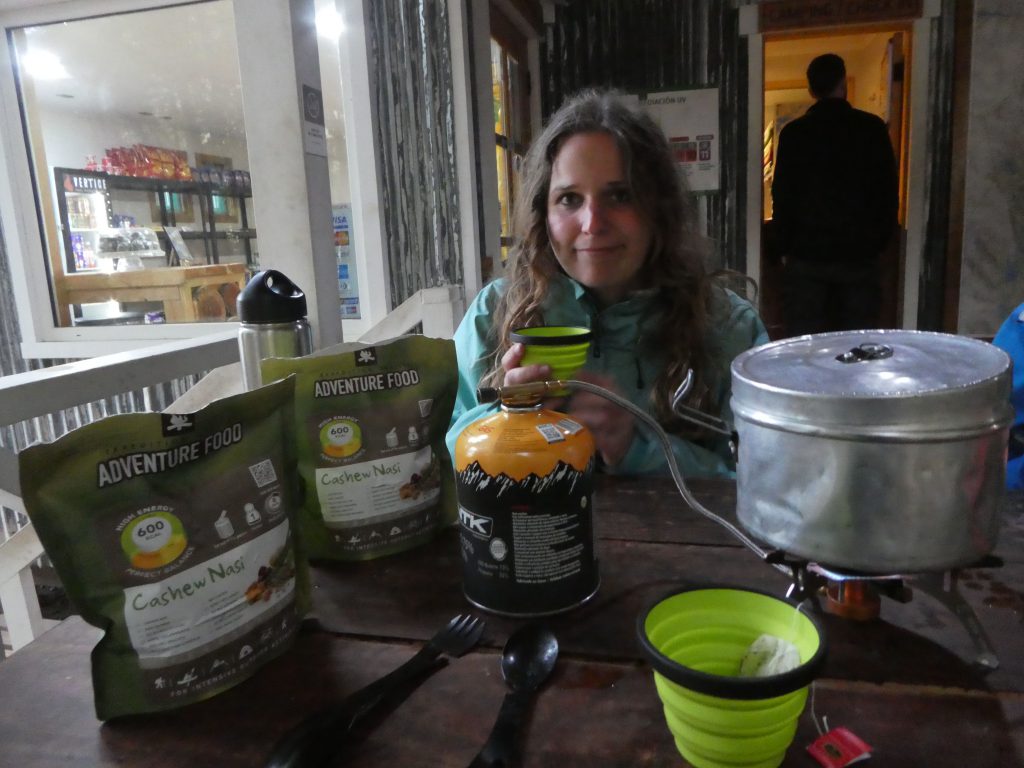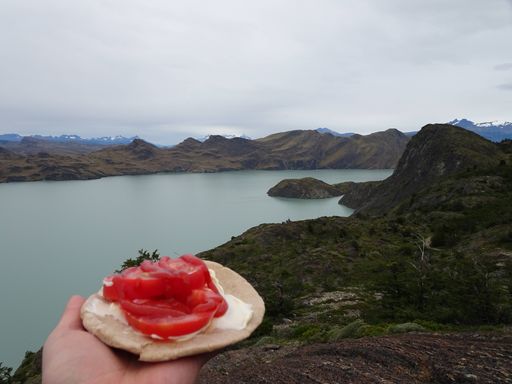You plan to hike the W-trek in Torres del Paine National Park and don’t know what to put on your packing list? Check out our tips to be well prepared! We’ll give you some advice about what you should and should not take, and what to consider while packing.
The weather conditions in Torres del Paine National Park can change very quickly. They say you can experience four seasons in a day. It can rain, snow, be extremely windy or be very hot. You should be prepared for this. We were quite lucky. While the weather forecast said it was going to be a rainy week, we only had a bit of rain at night and once during the day. Wearing layers is very important and you will find yourself adding or removing layers during the day (well, that’s what we did).
Another important aspect to keep in mind, while preparing your Torres del Paine packing list, is to pack light. You have to carry everything up and down the hill for multiple days. Trust us; you will be very happy about every gram that you did not pack. You can think of larger items such as an additional sweater, pants or a second water bottle. However, also the small items matter. Especially for longer treks, you can choose to wash your clothes, instead of taking some extra. Or if you want to take a soap bar, do not take the entire bar, but cut off a small part that will last for multiple days. If you take toothpaste, you can take a small travel toothpaste, instead of a large tube.
Items we would recommend to put on your packing list for the W-trek in Torres del Paine:
Backpacks
- Ralph took a 70L-backpack
- Janice took a 70L-backpack
- 18L packable daypack (1x)
Our initial idea was to bring one large 70L-backpack and a smaller one of 35L. However, we needed two 70L packs to fit everything, because especially the camping equipment took a lot of space. To reduce strain on your body, we were told that it is best to pack everything inside your backpack. Especially heavy equipment that is attached to the outside of your bag is bad for your posture. We can also highly recommend bringing a separate packable daypack. In many occasions, you can leave your backpack at a ranger station and only hike with your daypack – your body will thank you (e.g. Mirador Británica or Las Torres). A packable daypack is light, small and you can easily bring essentials, such as water, a camera, a jacket and food.
Camping equipment
- Two-persons tent (1x)
- Sleeping bag (1x extra-long up to -7 degrees, 1x normal length up to -15 degrees).
- Mattress (2x)
- Stove (1x)
- Gas canister (1x – small one is sufficient for 5 days)
- Foldable cups (2x – for coffee or tea. We bought them back home.)
- Cooking pot (1x
- Spork (2x)
- Trekking poles (2x)
- Sleeping bag inlet (1x)
When renting the camping equipment, you should always check your gear in advance! Two hikers we met rented a broken stove that turned out to be quite dangerous, because big flames came from the hose!
Sleeping bag inlet & tent
Janice preferred to sleep in her own sleeping bag inlet, because you never know how clean a rented sleeping bag is. Ralph did not use one. We learned the hard way that you should always open all the ventilation windows when erecting your tent. The windows provide you with sufficient oxygen, but also prevent condensation on the inside. Well, that’s exactly what happened to us on the first night; the tent was wet and water was dripping on us.
A two-person’s tent is quite small if you hike with two backpacks. You have to store the backpacks in the “entrance compartment” of the tent. We first placed a garbage bag on the grass to prevent our bags getting wet and dirty. If you have to use the toilet in the middle of the night, the bags are in the way and you have to climb over them. Therefore, to prevent night walks to the toilet, we did not drink a lot during the evening. If you would prefer more space, you could consider taking a three persons tent. However, such a tent is generally heavier.
Cooking utensils
We took a large gas canister, but a small size would have been sufficient. In addition, many hikers leave gas canisters at campsites, which you can use in case you run out of gas.
Foldable silicone cups were great for coffee and tea. They are small, lightweight and pretty useful. For eating, we did not bring bowls, because we found them too big and way too expensive to rent. You can easily eat from the pot. This further saves you time doing the dishes.
Clothes Janice
- Rain jacket (1x)
- Fleece jacket ( 1x – I was happy about it, because my rain jacket is very thin. So if you have a warmer rain jacket, you might not need an additional fleece jacket)
- Rain pants (1x)
- Fleece pullover (1x)
- Sports top (1x)
- T-shirts (1-2x – breathable and quick-dry)
- Long sleeve shirt (1x)
- Base layer shirt and pants (1x – you can wear it in the day, I mainly used it at night)
- Zip-off pants (1x)
- Hiking boots (1x – waterproof)
- Flip flops (1x – for showering & chill time after the hike)
- Gloves (1x)
- Hat (1x)
- Buff (1x – it functions as a scarf, but also as a hat)
- Underwear (4x) and socks (3x – merino wool – doesn’t smell)
- Sport bra (1x), normal bra (1x)
Clothes Ralph
- Rain jacket (1x)
- Rain pants (1x)
- Fleece (1x)
- T-shirt (3x)
- Long sleeve shirt (1x)
- Base layer (1x – long sleeve & pants)
- Zip-off pants (1x)
- Trailrunners (1x – not waterproof)
- Flip flops (1x – for showering & chill time after the hike)
- Gloves (1x)
- Hat (1x)
- Buff (1x)
- Underwear (4x) and socks (3x – merino wool – doesn’t smell)
The first couple of days we always wore our jackets. We often were too warm and the ventilation (pit zips) did not sufficiently cool us. We found out that wearing our rain jacket was overrated. Without the jacket, the ventilation was extremely good and because of the walking, we were never cold. When we took a break, we added another layer or put on our jacket to prevent cooling down. Ralph’s favourite clothes system during the day was: a base layer with a t-shirt on top. He was never too hot or too cold. Many hikers wore a base layer (pants) with a short-pants on top. They said this was warmer than shorts, but cooler than long pants. However, we did not try this, but it looked comfortable.
Before our journey, Ralph was in doubt whether to bring his waterproof hiking boots or get trailrunners. Boots are sturdier, waterproof, but also heavy and warm. Trailrunners are light and breathe well, but are not waterproof. He decided to bring trailrunners, because we would also travel to warmer places (well, we did not make it that far – see our post ‘We will be back!‘), where boots probably were going to be too warm. The trailrunners functioned perfect: no injuries, no cold and wet feet (not even during a morning of light rain or crossing streams). However, he did not have to use the trailrunners in heavy rain.
Cosmetics Janice
- Tooth brush
- Hair brush
Cosmetics Ralph
- Tooth brush
- Glasses
- Stuff for lenses
Shared cosmetics / medicine
- Soap bar
- Blister Plasters
- Anti-diarrhea pills
- Paracetamol
- Toilet paper
- Tooth paste
- Sun screen
- Lip balm with sunblock
- Deodorant
- Mosquito spray
- Ohropax
- Wet wipes
- Wound disinfection
- Gauze bandage
- Electrolyte-glucose-mix
Food
- Self-made porridge mix (10x)
- Milk powder (for 2 L)
- Trail food (6x)
- Instant noodles (4x)
- Tea bags
- Instant coffee (they gave it to us together with our free breakfast at the hostel, so we didn’t have to buy a whole package)
- Dry fruit
- Nuts
- Cheese
- Cream cheese
- Cooked eggs (6x)
- Pita breads
- Tomato
- Avocado
- Fresh fruit for first days (apples and oranges)
- Ketchup
Our breakfast
For breakfast, we made several self-made porridge mixes. They contained oats, nuts and raisins (we forgot to add cinnamon). Next to it, we packed milk powder. For breakfast, we first cooked water, added the milk powder, and finally the porridge-mix. Breakfast tasted nice and gave us a good base for the day. We drank tea or instant coffee.
Two things we would improve the next time:
- We made way too much porridge mix and should calculate better how much we actually need per day.
- As bananas were too heavy, we should have added more raisins or some sugar to make the mix a bit sweeter.
Our lunch
For lunch, we had pita breads. We ate these with cheese, cream cheese, boiled eggs, ketchup or avocado. It is also nice to have some fresh vegetables and fruit. We took a few tomatoes, apples and oranges. Be careful not to take too much, because they are relatively heavy for the energy they provide. We are not a big fan of peanut butter, but it is good – calorie packed – hiking food.
Nuts, cereal bars and dried fruits form great snacks. In addition, we bought two packages of fruit-sugar-powder. We really liked it, because the sugar gives you energy and it is nice to taste something else than water once in a while.
Our dinner
For dinner, we packed adventure food and instant noodles. In particular we liked the Adventure food. It was very lightweight, had enough kilocalories per meal and the taste was very good. You can choose different meals. We had Cashew Nasi, Curry Fruit Rice and Pasta al Funghi, which we bought at the Bever (Dutch outdoor shop). However, it is also possible to make your own freeze-dried food. This is probably a cheaper option, but we never tried this. Cheaper alternatives are rice or couscous with some sauce.
Electronics
- Camera Ralph
- Camera Janice
- Water purifier
- Power bank (2x)
- Mobile phone (2x – one would have been enough for us, because we mainly took pictures with the camera. But it’s nice if you want to listen to music or an audio book in between)
- Head lamp (2x)
- Spare batteries
Others
- Sun glasses (2x)
- 2nd shoe laces (1x – in case one pair brakes)
- Rain cover for backpack (1x – there was already one integrated at Ralphs backpack)
- Water bottles (2x – 1 and 0.8 L)
- Travel towel (2x)
- Rubbish bags (for your waste and as a “floor”. Specifically, you can put your bags on it so that they stay dry).
Considering these tips above, you should be able to make your own perfect packing list for the W-trek in Torres del Paine. This way, you will be well prepared for your 5-day hike in the Torres del Paine National Park.
What would you recommend to take on a multiple day hike? Which food did you take? Let us know in the comments about your experiences.



